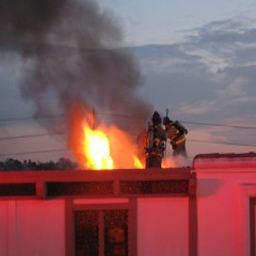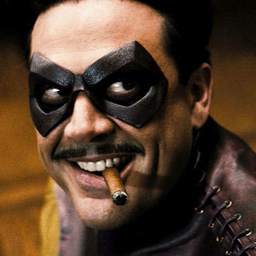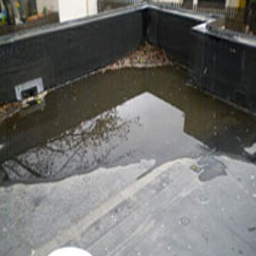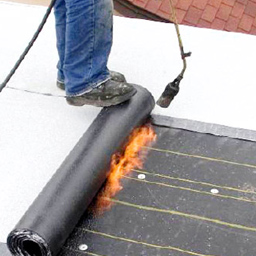Public Misconception
The material used in applying a flat roof is technically known as ‘Bitumen’, but more commonly known as asphalt. Bitumen by itself is perfect for roofing, as it has good water proofing qualities; however, Torch applied roofing needs to have something added to it to stabilize its inability to expand and contract. Asbestos fibers were the perfect answer for this problem until the abuses and well documented dangers of it were fully disclosed. Other additives were soon found to replace the asbestos. What resulted is known in the roofing industry as ‘Modified Bitumen’.
Modified Bitumen
Modified Bitumen, which is nothing more than asphalt with additives, comes in two forms: SBS Self-Adhered or mop applied, and APP torch applied. The ‘torch applied’ member of the Modified family is marketed as a rubber membrane, which is very misleading due to the fact that the modifiers or additives used in the manufacturing formula actually contains no rubber at all; APP (atactic polypropylene) uses plastic type modifiers, not rubber. So do not be misled into believing that an APP NY flat roofing contains any rubber, despite such inappropriate names for it as ‘rubberoid’. These so called ‘rubber roofs’ are the roofing industries wolf in sheep’s clothing.

Fire Dangers

While the material itself used in APP is bad enough, the way in which it is applied is perhaps even worse. APP Modified Bitumen requires the use of a torch and propane tank to apply it to a roof. The dangers of working with an open flame on your building or residence should be taken very seriously. With all the precaution and experience in the world, the law of averages is against you when you spend the entire day shooting a flame at high volume onto your building. A simple Google search with the key words ‘roof torch fire’ will present you with enough articles on fires related to torch applied roofing to leave you wondering how anyone would ever use this product.
NYFD Speaks Out Against Torch Applied Roofing
In June 1999, the NYC chief fire marshal signed on to make it illegal to use a torch on a wood structure roof in all of the 5 boroughs, sighting that there was an average of 35 roof fires a year started from this practice. The law specifically states that, “the penalty for violating these rules, built into the rules themselves, is arrest for endangerment of property. Further, anyone sanctioning the illegal use of propane on roofs, including board members, engineers, architects, attorneys who draw up contracts, managing agents and roofing companies, can all be subject to arrest.”
A Fire Story
In our years in the New York roofing industry, we will occasionally find ourselves in some conversation or debate with another roofer or roofing company regarding our strong opinion against the use of torch down roofing. This conversation will generally start with the “pro-torch roofer” adamantly defending the effectiveness and quality with which he has used the product for years and years.
After hearing a long winded testimonial on the greatness of torch down, we will smile, and in quiet voice, one of us will say “tell me about the fire.” We will then invariably be given some gut-wrenching story about how one of the new guys on the roof was not watching and shot a flame onto something, and how the fire trucks came late, and so on. It happens every time. Don’t let yourself become one such story.
Insurance
In the preceding “fire dangers” section we provided an overview of the potential for personal injury and property damage resulting from the practice of torch roofing. The contractors’ liability insurance company is also well aware of this potential. After years of paying heavy claims for torch related fires, insurance companies have put strong and clear exclusions in the policies that forbid the use of an open torch to install roofing. In order to use torches for roofing applications, a specific endorsement must be purchased for a policy to cover such operations. This endorsement can cost more than the base premium itself.
The roofing trade in general gets hit hard for its workers compensation and liability insurance, due to the obvious dangers associated to working at heights. There are also specific endorsements just to perform any type of roof operation. It is likely that the NY Roof contractor installing your torch down roof has not made the $100,000 + investment required to be properly endorsed to install a torch roof.
Bottom Feeding
So far we know three things about torch down roofing: (1) It is misrepresented as a rubber roof; (2) it is a fire hazard; and (3) it is very expensive to insure. Compared to many other options in the industry not affected by these issues, why would any contractor in the world choose to promote and use this product? It’s cheap! Cheap to buy, cheap to install, cheap equipment (torch and barbeque tank) and cheap unskilled labor. It can be said that the only redeeming quality for torch roofing is that it is the cheapest roof you can install on a NY flat roof. The small square foot price you get for your roof can appear very attractive. There are many systems out there, and it can be argued that all of them, if installed properly, are good roofs (even torch down). But there is one major shortcoming of a torch down roof. The shortcuts!
Flashings/details
A roof consists of the field and the flashings/details. Flashings/details would consist of wall tie-ins, HVAC units, drains, skylights, edge metals or any penetrations in the roof area. 90% of all leaks in roof systems originate at a flashing or detail. There are very specific procedures and costs associated with installing proper flashing or details (as per manufacturers specifications). In order to keep the direct cost of production at the lowest possible number, flashings and details are (more times than not) grossly neglected. They are generally just sealed with an application of roof cement. Instead of opening a drain assembly to properly compress the new roof into the drain, it is quickly cut around and sealed with tar.
Or instead of installing a new gutter edge metal, the roll is just overhung into the gutter and so on. This will happen at every possible detail that is in the field of the replaced roof. All that you will usually get with this roof is the rolls torched over the field and tar installed at all flashings/details. Simple and cheap. The contractor that chooses to use torch roofing is of the mind set that cheap price gets the job. Such a contractor is willing to use a product that they know is a fire hazard and that they likely aren’t insured to install.
Migrating water
Migrating water is a term used in the roofing industry that refers to the occurrence of water traveling between (2) layers of NY flat roofing. When a second layer of flat roof is applied directly over an original roof system, what is created is the potential for the water to infiltrate past the second installed layer, but not the first. This situation is generally referred to as a “floating roof.” Water trapped between (2) layers of flat roofing is harmful to the life expectancy of both layers of roofing. The trapped water will deteriorate and rot both layers from the inside out because the water in the system becomes trapped and will never dry. Most flat roofs are created with some level of pitch so it can move water to a drain or gutter edge.
The water between to layers of roof will begin to move with the pitch of the roof to a lower point. This migrating water may enter the roof system at a poorly flashed edge metal and not show up in your building until it reaches a center drain 30 feet away.
Indexing and finding leaks
Indexing and finding leaks on a floating roof with migrating water can be very difficult due to the fact that the entrypoint of the leak and it origin are rarely the same place.Now that we understand migrating water and a floating roof, here is how it applies to torch down roofing. In the above section on ‘Bottom Feeding’ we established that the average NY roofing contractor that uses Torch down roofing is of the mind set that cheap price gets the job, and that the most important details to keep a roof from leaking are more times than not, grossly ignored in order to keep his price as cheap as possible. This means that the new torch down roof system will, with the first few hot-to-cold cycles, begin to open at the flashing points and allow water into the system.
Installation
The installation of torch down roofing involves the use of a hand held torch, fed with propane from a tank. The three foot wide rolls are laid in position, and the roofer will begin to apply heat to the exposed portion of the roll and “kick” it a foot, then heat the next exposed portion of the roll and so on (see the cover). This procedure will stick the roll to the roof but will never make a 100% solid bond to the roof that is being covered. The new roll is now “spot stuck” at best and water can travel freely and “migrate” under the field of the new roof. We now have, from our cheap price mentality roofer, a poorly flashed, spot stuck roof system that is highly prone to allow migrating water.
Seam failure
Now that we have covered migrating water and its associated problems and results, we can discuss another common failure with Torch down roofing methods: Seam Failure. As we mentioned many times so far, a torch roof is applied with propane and a torch. When a full 3’x 33’ roll has been installed, the next roll is set next to it with a 4” overlap. It is then heated and “kicked out” just like the first roll. An overlapping seam is then created. This seam is “welded” together by applying enough heat to bond the seam and create a “bleed” of liquid material from the roll. This is the factory recommended procedure. If too much heat is applied on this seam, the product becomes damaged and will crack at the point where it was overheated. Water will then begin to leak into the crack in the seam. If not enough heat is applied to the seam, a welded bond will not be created and the seam will leak.
With as many feet of welded seaming done on a typical roof, it becomes highly probable that at least a few feet of these seams will be over or under heated due to human error. Failure of just a few feet of seams will spell disaster for a roof that can allow the migration of infiltrated water. Irreversible damage to the roof system is likely to occur long before water is noticed entering the building.
SBS modified bitumen
If budgetary reasons are a factor in deciding which roofing system to use, a roof system that makes a 100% waterproof bond and has limited liabilities at seaming is the best choice. One such system that we recommend is the SBS modified bitumen, cold process system. This system has the following benefits:
1. Does not require the use of an open flame for there installation (no fire liability).
2. Insurance companies will not exclude this type of roofing system, but will exclude torch down and hot tar roofs in there endorsement pages (illegal to install on wood structure roofs).
3. When applied with a full application of modified roof cement, SBS roof systems make a 100% waterproof bond to the roof they are covering (no migrating water).
4. Seaming is done with the application of modified roof cement, all but eliminating the possibility of human error of making a proper seal (no over or under heating seams).
5. It will primarily be installed with a white granulated surface, effectively eliminating the need for surface protecting maintenance, and is very durable for foot traffic.
6. The entire installed roof system is generally the same cost or slightly more expensive per square foot than a comparable torch applied system. (Large price differences are usually related to the differences in the proposed flashings and details and not the actual field portion of the roof)
In Closing
We hope this will help you when considering your options for roof repair or replacement. We all too often have to explain this story after the fact to someone that has been stung by the purchase of a torch installed roof system. While there are many decisions and options to consider when making a roof purchase, we do highly recommend that you eliminate any and all “torch down” flat roof systems and/or products when making your choice.





